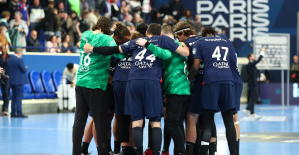There is a wonderful music video, maybe it's the most wonderful music video ever. Old people dance together, it moves you to tears. Behind them, on the wall, you see pictures, you see what they used to be.
Beautiful couples. They are still beautiful couples. Some dance alone because those they used to dance with have left. That's what life with people is all about. That's what makes it so beautiful and so sad. And Leonard Cohen sings "Dance Me to the End of Love".
At the beginning of "Abbruch Kante", the new "crime scene" in Cologne, Peter and Inge dance together. You've dressed up. You still have each other. You are not young anymore. They drank champagne. They dance to the end of love, of time. your time.
Then they lie down on the bed like Stefan Zweig and his wife did back in the jungle of Brazil. And then they fall asleep. Two who have lost their homes. They said their wedding vows again. Wherever you go, I want to go too, where you die, I also want to die.
It's always somehow about dying in the "crime scene". "Abbruch Kante" is about living on. About the survival of the dead. Dead people, dead communities. Peter used to be the mayor of Bützenich. That's not far from the Cologne city limits. Bützenich does not exist. It is the cross sum of Garzweiler and Lützerath and a dozen other villages that were completely or almost eaten up by lignite mining.
Since the demolition edge of coal mining came up to the town limits, there has been Alt-Bützenich and Neu-Bützenich. The abandoned village and the new village that the "corporation" (you have to think of it as RWE) put the expellees from the edge of the area in the area.
The abandoned village – living, lived-in architecture, old courtyards, the church, a wonderful brick thing, stands defiantly in the middle – is gradually being overtaken by nature. And the new village – aseptic architecture, circling streets, model houses, the church, a perverted highway chapel thing, is right in the middle, nature doesn't stand a chance in the cemented front yards of horror. They are both dead. "Abbruch Kante" is actually a zombie film.
Eva and Volker A. Zahn, who wrote the screenplay, and Torsten C. Fischer, who directed it, is not about a cheap contribution to the debate on resistance to lignite mining. They figure that out quickly. They are concerned with an in-depth exploration of the area in which all this is taking place, with giving the real victims of the forced resettlement a face, a story.
They make that clear with Volker and Inge. In order to show people and fade in their names, which are not the names of the actors, but those of the characters who are fighting with the wounds on the edge of the gigantic wound in the landscape, which the fight for their home, for their village, for their togetherness has beaten inside them.
The obligatory dead man, without whom Freddy Schenk and Max Ballauf, the inspector who is increasingly driving towards the edge of his (private) existence, would probably never have left their actual big city biotope in the land of the digging dinosaurs, lies shot dead in his deserted one House in Alt-Bützenich. dr His name was Franzen.
He was the village doctor of Bützenich. He wasn't a nice person. He bought up the houses of people who didn't want to sell to the company. But when Alt-Bützenich didn't go under the diggers and the old Bützenichers wanted to return, he didn't sell the land back.
It wasn't too long ago that "Abbruch Kante" would have been a completely different film. The story of Alt-Bützenich would have been told as an anti-capitalist horror story. With a villain from some management level who could be arrested in the end, responsible for the disaster that people do to each other under economic pressure.
Of course, “Abbruch Kante” is also a horror story. But it has become something that promises to become a trend in “Tatort”, a kind of post-ideological trend. An environmental study. A case of trauma impact research.
The commissars come to the village, as commissars like to come to villages. And the longer they stay - compelled by Freddy Schenk's lovely old but not very functional Ford Caprice - the deeper they dig into the tales of the ghosts that were once a village community.
The father whose daughter died protesting against the dredging. The sexton of the church, who now runs the village pub ("Zum crooked ox"), which nobody comes to anymore. The Doctor's beautiful widow who lost herself and custody of her son to red wine in the soulless new house.
The Peter that Inge promised to follow wherever he goes, to die where he dies, and who is dead now, while the Peter that the paramedics were able to save walks around like a ghost in his own life , between two houses in two villages, neither of which can be his.
Faces are important in this film. Loneliness that has become an image. Drone flights over the battered country. The inspector at the crossroads of his life (can you still make the change from old Ballauf to new Ballauf in your early sixties).
Nobody in Bützenich is interested in politics. And in the end you don't know if that's really good news.

 United States: divided on the question of presidential immunity, the Supreme Court offers respite to Trump
United States: divided on the question of presidential immunity, the Supreme Court offers respite to Trump Maurizio Molinari: “the Scurati affair, a European injury”
Maurizio Molinari: “the Scurati affair, a European injury” Hamas-Israel war: US begins construction of pier in Gaza
Hamas-Israel war: US begins construction of pier in Gaza Israel prepares to attack Rafah
Israel prepares to attack Rafah Spain is the country in the European Union with the most overqualified workers for their jobs
Spain is the country in the European Union with the most overqualified workers for their jobs Parvovirus alert, the “fifth disease” of children which has already caused the death of five babies in 2024
Parvovirus alert, the “fifth disease” of children which has already caused the death of five babies in 2024 Colorectal cancer: what to watch out for in those under 50
Colorectal cancer: what to watch out for in those under 50 H5N1 virus: traces detected in pasteurized milk in the United States
H5N1 virus: traces detected in pasteurized milk in the United States Private clinics announce a strike with “total suspension” of their activities, including emergencies, from June 3 to 5
Private clinics announce a strike with “total suspension” of their activities, including emergencies, from June 3 to 5 The Lagardère group wants to accentuate “synergies” with Vivendi, its new owner
The Lagardère group wants to accentuate “synergies” with Vivendi, its new owner The iconic tennis video game “Top Spin” returns after 13 years of absence
The iconic tennis video game “Top Spin” returns after 13 years of absence Three Stellantis automobile factories shut down due to supplier strike
Three Stellantis automobile factories shut down due to supplier strike A pre-Roman necropolis discovered in Italy during archaeological excavations
A pre-Roman necropolis discovered in Italy during archaeological excavations Searches in Guadeloupe for an investigation into the memorial dedicated to the history of slavery
Searches in Guadeloupe for an investigation into the memorial dedicated to the history of slavery Aya Nakamura in Olympic form a few hours before the Flames ceremony
Aya Nakamura in Olympic form a few hours before the Flames ceremony Psychiatrist Raphaël Gaillard elected to the French Academy
Psychiatrist Raphaël Gaillard elected to the French Academy Skoda Kodiaq 2024: a 'beast' plug-in hybrid SUV
Skoda Kodiaq 2024: a 'beast' plug-in hybrid SUV Tesla launches a new Model Y with 600 km of autonomy at a "more accessible price"
Tesla launches a new Model Y with 600 km of autonomy at a "more accessible price" The 10 best-selling cars in March 2024 in Spain: sales fall due to Easter
The 10 best-selling cars in March 2024 in Spain: sales fall due to Easter A private jet company buys more than 100 flying cars
A private jet company buys more than 100 flying cars This is how housing prices have changed in Spain in the last decade
This is how housing prices have changed in Spain in the last decade The home mortgage firm drops 10% in January and interest soars to 3.46%
The home mortgage firm drops 10% in January and interest soars to 3.46% The jewel of the Rocío de Nagüeles urbanization: a dream villa in Marbella
The jewel of the Rocío de Nagüeles urbanization: a dream villa in Marbella Rental prices grow by 7.3% in February: where does it go up and where does it go down?
Rental prices grow by 7.3% in February: where does it go up and where does it go down? Even on a mission for NATO, the Charles-de-Gaulle remains under French control, Lecornu responds to Mélenchon
Even on a mission for NATO, the Charles-de-Gaulle remains under French control, Lecornu responds to Mélenchon “Deadly Europe”, “economic decline”, immigration… What to remember from Emmanuel Macron’s speech at the Sorbonne
“Deadly Europe”, “economic decline”, immigration… What to remember from Emmanuel Macron’s speech at the Sorbonne Sale of Biogaran: The Republicans write to Emmanuel Macron
Sale of Biogaran: The Republicans write to Emmanuel Macron Europeans: “All those who claim that we don’t need Europe are liars”, criticizes Bayrou
Europeans: “All those who claim that we don’t need Europe are liars”, criticizes Bayrou These French cities that will boycott the World Cup in Qatar
These French cities that will boycott the World Cup in Qatar Archery: everything you need to know about the sport
Archery: everything you need to know about the sport Handball: “We collapsed”, regrets Nikola Karabatic after PSG-Barcelona
Handball: “We collapsed”, regrets Nikola Karabatic after PSG-Barcelona Tennis: smash, drop shot, slide... Nadal's best points for his return to Madrid (video)
Tennis: smash, drop shot, slide... Nadal's best points for his return to Madrid (video) Pro D2: Biarritz wins a significant success in Agen and takes another step towards maintaining
Pro D2: Biarritz wins a significant success in Agen and takes another step towards maintaining


















